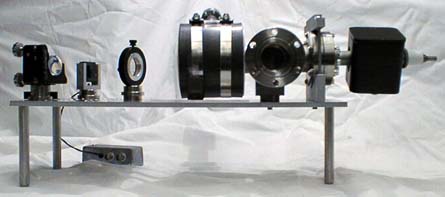
A vacuum chamber containing a pyramidal mirror assembly, a Rubidium source and a small ion pump

A circuit box incorporating all the necessary driving and control electronics.

 .
The setup required a roughly 4 ft X 6 ft optical table, with dozens of
mirrors, lenses, and waveplates to be aligned to produce the six trapping
laser beams required for the demonstration. This meant the apparatus
had to be preassembled on a movable table and then wheeled into the lecture
hall ~30 minutes before the lecture. Obviously, the mass and complexity
were still too great for the apparatus to be portable.
.
The setup required a roughly 4 ft X 6 ft optical table, with dozens of
mirrors, lenses, and waveplates to be aligned to produce the six trapping
laser beams required for the demonstration. This meant the apparatus
had to be preassembled on a movable table and then wheeled into the lecture
hall ~30 minutes before the lecture. Obviously, the mass and complexity
were still too great for the apparatus to be portable.
Three key technological developments were needed to make a portable trap a reality. The first, inexpensive and lightweight microwave modulation of diode lasers, had been developed by Paul Feng and was already in routine use in our research laboratory.
Subsequently, building on some ideas of Won Ho-Je in Korea, Rob Williamson and Paul Voytas developed a pyramidal trap that only requires one laser beam, with a resulting drastic simplification in the number and complexity of the optical elements.
Finally, Carl Wieman's group invented the DAVLL (Dichroic-Atomic-Vapor Laser Lock) method for simplified locking of a laser to an atomic resonance line (Applied Optics.vol.37, no.15; 20 May 1998; p.3295-8).
Exploiting these new technologies, in the fall of 1998 Ray Newell, a Physics graduate student, designed and built a portable magneto-optical trap. It is modular so that it can be broken down to fit inside a portable equipment case. It has been demonstrated to work, but its portability and reliability have yet to be tested. The total cost was about $14K, and the weight is less than 50 pounds.
The system can be broken down into three main components:



For more details, download Ray Newell's Master's Thesis.